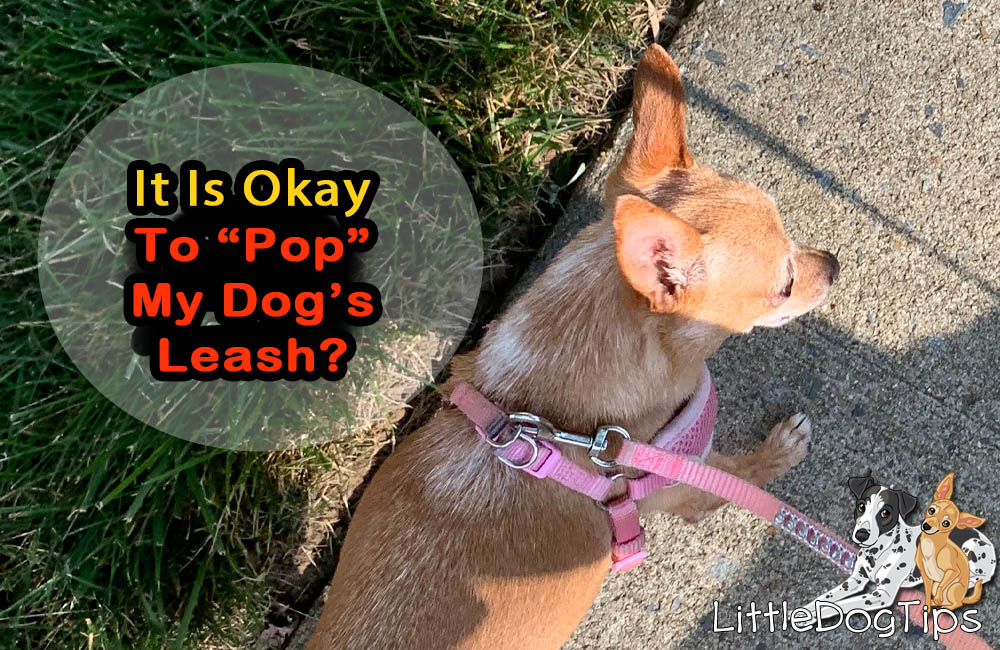
Have you ever been told to “pop” your dog’s leash or collar?
You might have seen this technique in an article, a book, or even on TV.
Like many dog training techniques coined by popular dog trainers, popping a leash is intended as a way to deliver an attention-getting correction and instantly change your dog’s behavior.
What Does It Mean To Pop Your Dog’s Leash?
Popping a leash means to quickly yank on your dog’s leash, delivering a sharp tug to their collar.
Sometimes it’s done with a training collar like a prong collar or choke chain, tools designed to apply concentrated pressure to the dog’s neck and throat. Or, it’s done with a regular flat collar.
Is It Safe To Pop Your Dog’s Leash?
No. Popping a dog’s leash can injure the soft tissue that supports the dog’s neck, not to mention the spinal cord.
While you might not expect to see serious damage from a single incidence, there’s no “safe” amount of pressure to apply when using leash popping as a correction, nor a safe number of incidences your dog’s neck can withstand before developing lasting damage.
Trauma to the thyroid gland, located at the front of the dog’s neck, has been linked to chronic thyroid issues.
Pressure on the spine can lead to disc herniation, chronic pain and paralysis.
Small dogs, in particular, are prone to collapsing trachea, an incredibly common condition in which the windpipe narrows, causing a honking cough and trouble breathing, which can be fatal.
It doesn’t take a lot of force to cause trauma to the neck and spine. Whether one thinks they’re applying a safe, moderate amount of force, or loses their temper and jerks their dog during an especially frustrating walk, there’s no way to know if a leash popping incidence will incur serious damage or – as intended – a merely temporary, painful injury.
Does a Leash Pop Simulate A Mama Dog’s Correction?
One of the common arguments for leash corrections for dogs is that it’s similar to the way a dam (mama dog) would bite her puppies on the neck to correct them.
But it’s unclear what situation would call for a mother dog to correct her puppies, nor whether there’s any evidence that it happens – or that a dog would mistake the sharp pop of a leash for some form of communication from their biological mother.
When puppies are just a few weeks old, they’re so small that it’s safe for their mother to carry them around in her mouth. Once they’re too large, their scruff can no longer support their body weight, nor will it protect them from damage caused by corrections to their neck area by any animal or human.
Why Leash Pops Seem To Work
There are still dog trainers today that use forceful techniques like leash pops to train dogs on walks.
And when dogs are delivered a painful “pop,” they’re bound to stop what they’re doing and avoid another painful moment, even if that means shutting down in the moment.
Leash pops stop a dog in their tracks. They do not teach a dog when it’s okay to sniff around, how to react to strangers on walks, how to ignore distractions, and how to trust and communicate with their human.
Like most quick-fixes in life, a leash pop that instantly stops a behavior does not create lasting results, and is not without risks and side effects.
Training a dog to stop pulling at a leash is very doable, even for the average pet parent, without the use of force or risking injury. And it doesn’t have to be so frustrating that you’ll ever feel the need to give your dog a “pop.”
If you’re struggling with leash walking and looking for anything to make walks peaceful, even enjoyable, it’s time to reframe the walk.
Walking your dog doesn’t mean they have to stay perfectly by your side at all moments. It’s their walk too, and it’s normal, even desirable, for them to sniff, watch passersby and other animals, and explore their environment.
Walking is a time to de-stress. And when your dog seems out of control, it’s time to work on attention-getting skills – this means carrying treats, playing games like “red light, green light,” and making it more fun, more interesting, and more rewarding to walk with you – rather than towards whatever triggers those unwanted behaviors.
Changing Perspectives
If you’ve once used techniques like “popping the leash” or even considered them, you’re not alone. Every pet parent, experienced trainer, everyone has been in an embarrassing, stressful situation when their dog just lost their marbles during a walk, with no way of getting their attention back.
More and more people are opening their eyes to humane, reward-based, science-backed, dog-centric training. Having the strength to take a deep breath, stay calm, and gradually gain back your dog’s attention is a million times more impressive, better for your mental health, and better for your dog’s safety… than jerking on their leash.

